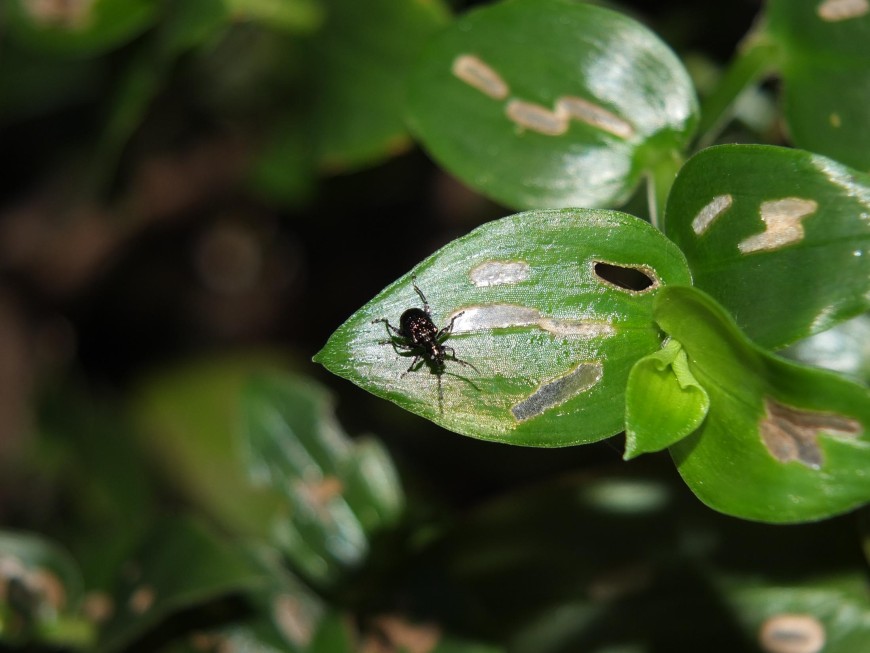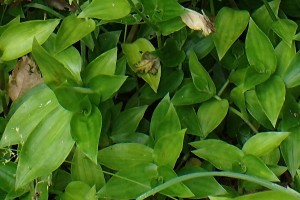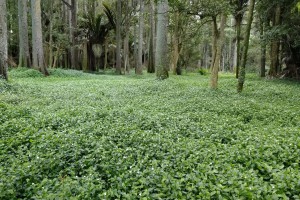Tradescantia stem beetle
History in New Zealand
The tradescantia stem beetle is native to south-eastern Brazil and north-eastern Argentina. It was first imported from Brazil by Manaaki Whenua - Landcare Research into containment for testing in 2009. Permission to release this beetle was granted by ERMA towards the middle of 2011, but releases did not begin until 2012 because of the need to clear the beetle of a gut parasite. The beetle is establishing well and showing early promise with widespread releases continuing. This beetle has not been used as a biocontrol agent anywhere in the world before.
How would I find/recognise them and what is their lifecycle?
Adults tend to be secretive and remain hidden in the foliage but can sometimes be seen feeding or resting on the upper leaves and shoots during the warmer months. They are shiny and black in colour with a distinct knobbly appearance when viewed close-up. Adults are about 4–5 mm long and females are usually slightly larger than males. Adults have survived up to 5 months in captivity.
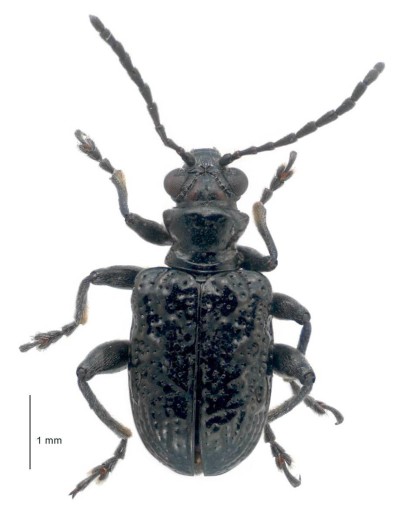
Image: tradescantia stem beetle.
Image: tradescantia stem beetle.
Females lay yellow eggs on the lower surfaces or undersides of the leaves or in leaf axils, mostly singly but sometimes in clusters. It is not known how many eggs they can lay but 100–200 eggs over several months seems likely.
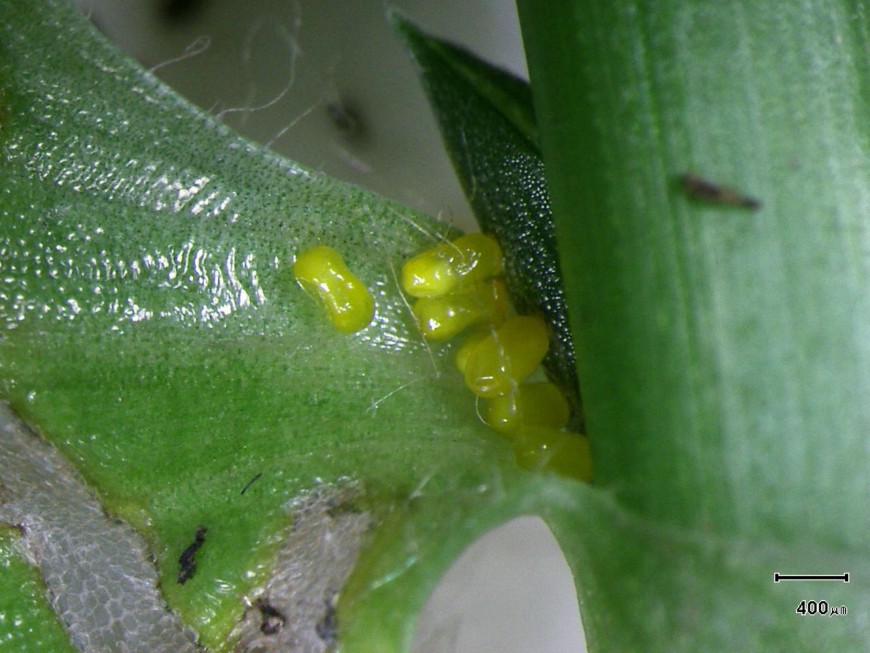
Image: tradescantia stem beetle eggs.
Eggs hatch after about a week into pale greyish-brown larvae which either mine the leaves and leaf stems or bore into mature stems. Larvae themselves will therefore be hard to see, but their damage (collapse and necrosis of stems) and brown frass may be visible. The larvae feed and grow through 4 or 5 instars before emerging to pupate.
Image: stem beetle larvae mining a stem.
Image: stem beetle larvae excised from a mined stem.
The pupal cocoons are extremely unusual and may be visible in the litter/soil, especially around the base of damaged plants. They are white, star-shaped and resemble styrofoam in texture and appearance. This may be another survival mechanism, as predators may be fooled into thinking they are larvae infected with a fungus.
Image: tradescantia stem beetle pupa.
New adults emerge from cocoons after about 2 weeks. Development from an egg to an adult takes 10-12 weeks at warm temperatures. The beetles are likely to complete 2-3 generations per year in New Zealand.
You may confuse some life stages of the tradescantia stem beetle with other tradescantia biocontrol agents. Tradescantia leaf beetle (Neolema ogloblini) and tip beetle (Neolema abbreviata) adults are a similar size but have different colouration. Leaf beetle adults are dark metallic bronze and tip beetle adults are black with yellow wing cases with black markings. Pupal cocoons made by the three species will be difficult to tell apart, but stem beetle pupae are more likely to be found lower down or in the litter.
See: Tradescantia stem beetle, Tradescantia leaf beetle.
How do they damage tradescantia?
Adults chew elongated windows in the upper surfaces of leaves, and may consume entire leaves but do not feed on stems or actively growing tips.
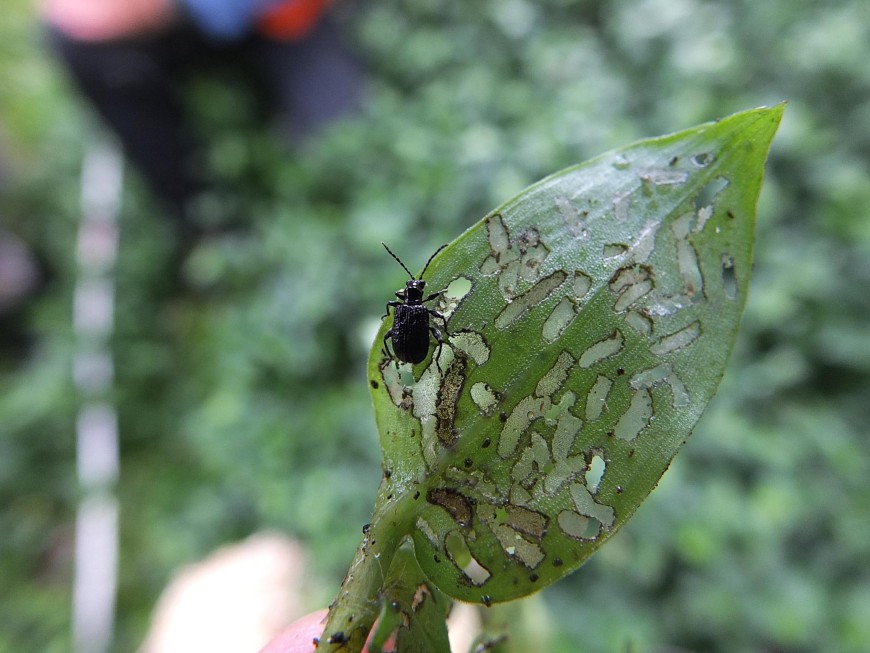
Image: adult stem beetle feeding damage.
The main damage is caused by larvae which bore into mature stems causing them to collapse.
Image: stem beetle larval mining damage.
Image: tradescantia dead stem from larval mining damage.
Will they attack other plants?
The stem beetle is highly host-specific and it is highly unlikely to attack anything other than tradescantia (Tradescantia fluminensis) and, possibly, very closely-related ornamental species such as T. albiflora.
How effective are they?
Early indications suggest that the stem beetle can clear dense patches of tradescantia, particularly in drier sites. The tradescantia stem beetle should complement attack by the tradescantia leaf beetle and the tradescantia tip beetle. A monitoring programme to measure the effectiveness of the three beetle species is underway.
Image: stem beetle damage.
How can I get the most out of this agent?
The beetles are not expected to disperse rapidly so it would be worth helping to establish them in all areas where they are needed.
How do I select a release site?
Read Guidelines for selecting release sites for biocontrol agents.
How do I collect them for release at other sites?
Collect beetles for redistribution either with a simple pooter or by using a garden-leaf vacuum machine. Modify the tube of the garden-leaf vacuum so that the beetles are collected and not sucked through. Take a sleeve of coarsely-woven material, with one end sewn shut and the other end open (old socks or pantyhose could be used), and fit it securely around the end so it forms a bag in the mouth of the tube.
We recommend that you shift at least 50 adults in the spring. Use a pooter to separate them from other material collected during the vacuuming process, which may include pests.
Alternately, you can collect and redistribute infested plant material. Note that if you wish to propagate and move tradescantia plants around in this manner you will need an exemption from the Ministry for Primary Industries.
How do I manage the release sites?
Avoid any activities that will interfere with the beetles, such as herbicide application. If you need to undertake control measures, avoid the release site.
Downloads
- pdf Tradescantia stem beetle pdf File, 361 KB
- pdf Tradescantia beetle comparison pdf File, 325 KB
Key contact


